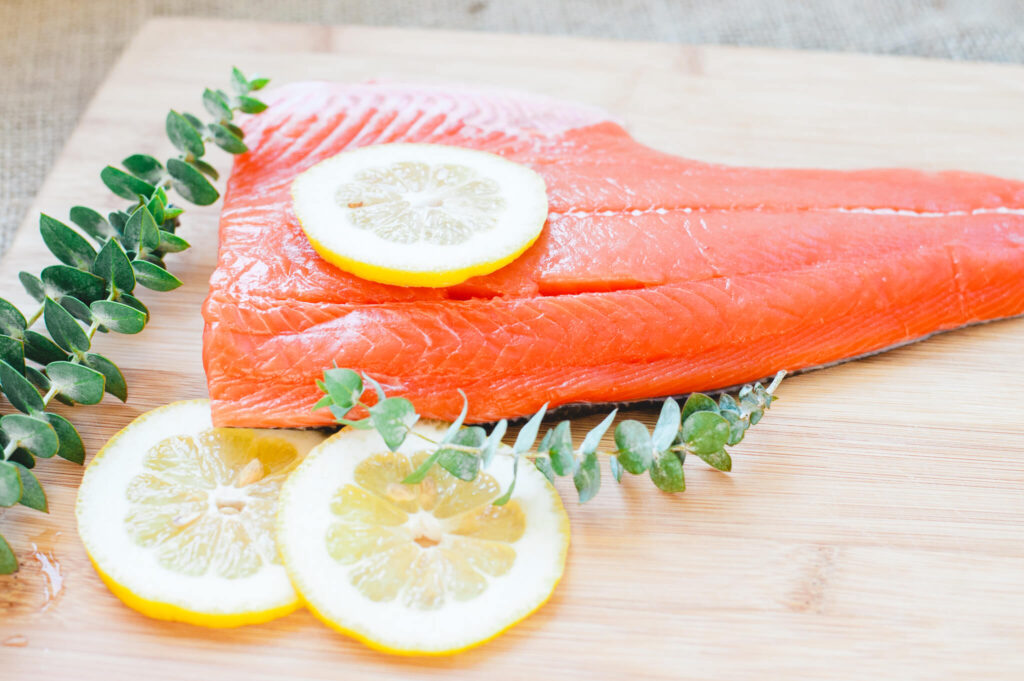Here’s why I personally eat and recommend seafood

It’s no secret that seafood is anti-inflammatory and good for your heart and your brain, but you’ve probably also heard that some people should avoid certain types. This is true. Of course, if you’re allergic to seafood, you should avoid it altogether. If you’re at higher risk for foodborne illness, you should avoid certain types of seafood.
However, on the whole, most people should increase their seafood intake for optimal health. But truth be told, there is a lot of information regarding seafood–what’s good, what is bad, and what to avoid, and it can be confusing! If you’re not allergic to it and you have questions about it, this post is for you.
I’m going to cut through the confusion and tell you about some of the nutrients found in seafood (including the famous “omega-3” fats), who should avoid which types of seafood (hint: not everyone), and let you in on some pro tips on selecting the healthiest seafood. Let’s begin by summarizing the impressive health benefits of eating seafood.
Health benefits of eating seafood
Seafood is a heart- and brain-healthy food and has been linked with lower levels of inflammation and reduced risks for bone fractures and some cancers.
When it comes to heart health, people who eat seafood as part of a nutritious diet tend to have lower risks for heart problems and a smaller chance of dying from heart disease—even if you have a history of heart disease. For example, if you have high levels of triglycerides, eating seafood may help to lower it. Seafood may also protect your heart from rhythm disturbances, help to lower your blood pressure, and improve the function of your blood vessels. Some studies show that people who eat seafood regularly have even lower risks than those who eat it occasionally.
Eating seafood can also help to reduce the financial costs of heart disease. A 2019 study published in PLoS Medicine calculated that Americans’ poor diets are responsible for an estimated $50 billion per year in healthcare costs associated with heart disease. The researchers found that out of the 10 dietary factors they looked at, consuming too little seafood was the second largest contributor to these staggering costs, behind consuming too few nuts and seeds.
[Felicia tip: Enjoy more nuts, seeds, and seafood for heart health.]
Seafood also helps the brain. People who eat seafood tend to have lower risks for stroke, depression, and Alzheimer’s disease. Intake of seafood during pregnancy is linked with better brain and vision development in the baby. (See the section below on selecting the best seafood that’s safe to eat during pregnancy.)
Beyond heart and brain health, eating patterns that are higher in seafood have been linked to decreased risks of hip fractures and colon and rectal cancers. These nutritious eating patterns can also decrease your risk of experiencing excess weight and obesity.
Fish and shellfish (crustaceans) are two of the top eight foodborne allergens and can cause severe and life-threatening allergic reactions (anaphylaxis) in some people. If you are seriously allergic to seafood—or any foods—the best thing is to avoid them completely [and speak with a registered dietitian who can help ensure you’re getting the nutrition you need.]
Healthy Aging- nutrients in fish
Seafood is full of nutrients for good health, including healthy fats, lean protein, vitamins, and minerals.
Seafood is lower in saturated fat than red meat and is widely known for its healthy unsaturated fats called omega-3 fatty acids. Deficiency in omega-3 fatty acids is linked to heart disease, mood disorders, some cancers, and arthritis. There are two main omega-3 fatty acids in seafood: EPA (eicosapentaenoic acid) and DHA (docosahexaenoic acid). Seafood is the richest food source of EPA and DHA.
DHA is particularly good for your brain because it helps to keep it functioning efficiently. Your brain and nerves are partly made from fat, and they specially prefer DHA. DHA deficiency is linked to serious cognitive problems, including Alzheimer’s disease. Consuming enough DHA regularly over the long term is linked to an improved ability to learn, improved memory, and a lower risk of cognitive decline.
You can also get DHA from algae and supplements. When it comes to omega-3 supplements, recent studies show that supplementing with omega-3 fatty acids may not have the same positive impacts as eating the food itself. Eating seafood as part of a healthy dietary pattern seems to have the most health benefits. However, if you don’t eat seafood, you may get some heart benefits from taking a fish oil supplement.
Seafood is also an excellent source of protein and contains essential minerals like vitamin B12, iodine, iron, selenium, and zinc. It is also one of the only foods with naturally occurring vitamin D.
Selecting the best seafood for your health
As you now know, seafood has many nutrients and health benefits. The 2020-2025 Dietary Guidelines for Americans recommends consuming at least 8 ounces (two 4-ounce servings) of seafood per week. If you are pregnant or breastfeeding, you can consume up to three 4-ounce servings of low-mercury seafood per week for your infant’s health. One 4-ounce serving of seafood is about the size of the palm of your hand.
Some seafood contains mercury (a toxin) that can harm the brain and nervous system. Everyone is advised to try to avoid fish that are high in mercury such as shark, swordfish, marlin, orange roughy, tilefish, bigeye tuna, and king mackerel. This concern is especially important for children and anyone who is pregnant or breastfeeding.
Opt for seafood that are lower in mercury such as shrimp, cod, sardines, wild Alaskan salmon, haddock, and non-king mackerel like Atlantic mackerel and Pacific chub mackerel. Examples of “oily” fish that contain higher amounts of omega-3 fatty acids and are also low in mercury are herring and trout.
If you’re concerned about the risks, Harvard T. H. Chan School of Public Health recommends, “the easiest way to avoid concern about contaminants is simply to eat a variety of fish and other seafood.”
Certain people should avoid eating raw seafood as they may be at higher risk for foodborne illness. This includes anyone who is pregnant, children under 5, adults over 65, and those with compromised immune systems. Raw seafood includes sushi and sashimi, raw shellfish, ceviche, seafood cooked “rare,” and smoked seafood (e.g., lox, kippered, or jerky).
When selecting fresh seafood, look for properly refrigerated ones, where the flesh looks shiny and firm, and that smells mild and not overly “fishy.” You can keep your seafood cold by picking it up toward the end of your shopping trip and ensuring it’s refrigerated as soon as you get home. If you can’t use it within two days, then wrap it up tightly and freeze it.
When it comes to cooking seafood, try to limit your intake of ones that are battered and deep-fried as they may be higher in salt, and the process of deep-frying can deteriorate the healthy omega-3 fats. More healthful ways to cook seafood are to bake, broil, or grill.
Final thoughts
Enjoying seafood 2-3 times per week has many benefits, including heart and brain health. Eating more seafood is one of the top dietary strategies for reducing healthcare costs from heart disease. Beyond its impressive links to heart and brain health, studies show that people who have a nutritious [diet/dietary pattern/eating style] that includes seafood also have lower levels of inflammation and reduced risks of bone fractures and certain cancers.
These health benefits are because seafood is one of the best sources of omega-3 fats and is also full of protein, vitamins, and minerals.
There are a few things to look out for when choosing seafood, including looking for ones that are low in mercury and ensuring they’re fresh and properly refrigerated.
Here is an excellent resource for the mercury content of various fish:https://www.nrdc.org/sites/default/files/walletcard.pdf
Now that you know the many health benefits of eating seafood 2-3 times per week, you may wonder where to get some recipes. Whether you want a quick and easy introduction to preparing seafood, some gourmet inspiration, or a review of your supplement regimen, consult an RD (like me) who can help.

References
Baseggio Conrado, A., Patel, N., & Turner, P. J. (2021). Global patterns in anaphylaxis due to specific foods: A systematic review. The Journal of allergy and clinical immunology, 148(6), 1515–1525.e3. https://doi.org/10.1016/j.jaci.2021.03.048
https://www.ncbi.nlm.nih.gov/pmc/articles/PMC8674817/
Ellis, E. (2021, October 25). How to reduce food poisoning from seafood. Eat Right. https://www.eatright.org/food/planning-and-prep/cooking-tips-and-trends/how-to-reduce-food-poisoning-from-seafood
Ellis, E. (2021, September 21). Brain health and fish. Eat Right. https://www.eatright.org/health/wellness/healthy-aging/brain-health-and-fish
Harvard T. H. Chan School of Public Health. (n.d.). Fish: Friend or Foe? Nutrition Source. https://www.hsph.harvard.edu/nutritionsource/fish/
Jardim, T. V., Mozaffarian, D., Abrahams-Gessel, S., Sy, S., Lee, Y., Liu, J., Huang, Y., Rehm, C., Wilde, P., Micha, R., & Gaziano, T. A. (2019). Cardiometabolic disease costs associated with suboptimal diet in the United States: A cost analysis based on a microsimulation model. PLoS medicine, 16(12), e1002981. https://doi.org/10.1371/journal.pmed.1002981
https://www.ncbi.nlm.nih.gov/pmc/articles/PMC6917211/
Jiang, L., Wang, J., Xiong, K., Xu, L., Zhang, B., & Ma, A. (2021). Intake of Fish and Marine n-3 Polyunsaturated Fatty Acids and Risk of Cardiovascular Disease Mortality: A Meta-Analysis of Prospective Cohort Studies. Nutrients, 13(7), 2342. https://doi.org/10.3390/nu13072342
https://www.ncbi.nlm.nih.gov/pmc/articles/PMC8308510/
Klemm, S. (2022, March 1). What are omega-3 fatty acids? Eat Right. https://www.eatright.org/food/vitamins-and-supplements/types-of-vitamins-and-nutrients/what-are-omega-3-fatty-acids
LeWine, HE. (2020, April 15). Fish oil: friend or foe. Harvard Health Publishing. https://www.health.harvard.edu/blog/fish-oil-friend-or-foe-201307126467
Moores, S. (2019, November 7). Pregnant safe sources of omega-3 fats. Eat Right. https://www.eatright.org/health/pregnancy/what-to-eat-when-expecting/pregnant-safe-sources-of-omega-3-fats
National heart, lung, and blood institute. (2019, December 17). Americans poor diet drives $50 billion a year in health care costs. https://www.nhlbi.nih.gov/news/2019/americans-poor-diet-drives-50-billion-year-health-care-costs
Newgent, J. and Klemm, S. (2021, October 18). Is raw seafood safe to eat? Eat Right. https://www.eatright.org/homefoodsafety/safety-tips/food/is-raw-seafood-safe-to-eat
U.S. Food & Drug Administration. (2022, May 3). Advice about eating fish. https://www.fda.gov/food/consumers/advice-about-eating-fish
